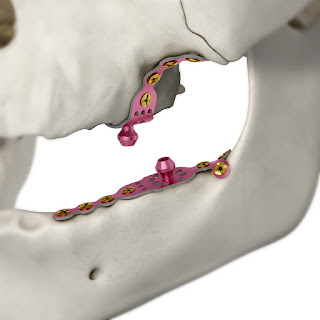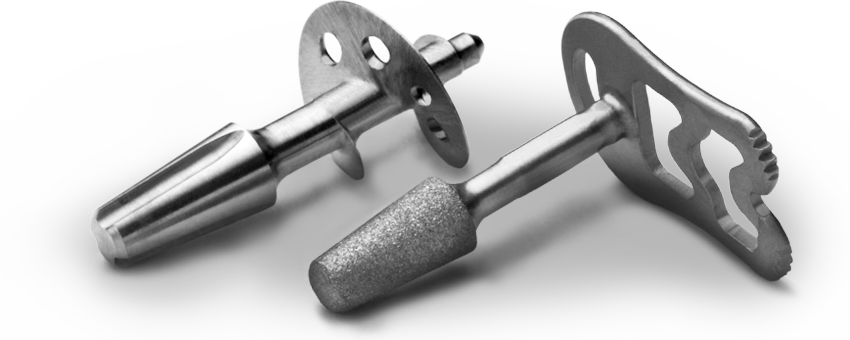DENTAL IMPLANTS - AN INTRODUCTION, TYPES AND INDICATIONS!!
Dental Implants!!
The dental implants are artificial substitutes for the roots of the lost natural teeth, which help to anchor the prostheses (false teeth/replacement teeth). The statement holds good in that the most popular form of dental implants available today are the root-form implants (anaform/ anatomical form/ in the form of natural tooth root). These are also technically called as the endosteal/endosseous implants, as they stay within the bone.
Root form implants are of different types as follows
- Blade form
- Cylinder form and
- Screw form (the most popular and widely used)
Other forms of dental implants, of rare usage, historic interest and lesser popularity, include - transosteal and subperiosteal implants.
- The transosteal implants
- These implant go through and through the bone.
- They engage cortical plates on either surface of the bone (the mandible) - the crestal cortical plate and the basal cortical plate.
- These implants do have a bony integration, however their use is limited only in the mandibular anterior regions between the mental foraminae.
- The posterior regions preclude bi-cortical penetration owing to the presence of the mandibular canal that hosts the neurovascular complex of the mandible.
- The subperiosteal implants
- These implants lie over the surface of the bone, under a thick fibrous membrane, the periostium, which forms the immediate covering of bony structures.
- They are lattice like and interconnecting Web-like structures that require customized fabrication (You can custom fabricate your subperiosteal implants from boneeasy.com - a company based in portugal and aslo from ctars3d.in - an indian start up based in Chennai, India)or modification of readymade (stock) structures.
- There may not be complete bony integration (fusion) on all surfaces- the integration is supposed to be both with bone and mucoperiostium.
- The lack of positive bony integration is mainly because they contact the cortical surface of the bone where you don't have much of the living cells that cause bone remodeling ( the osteoblasts, osteocytes, osteoclasts etc).
- Some times the frame may be fixated to the cortical plates using bone fixation screws to improve the primary retention/stability
- Although these implants can be of great use for patients with severe bone resorption, the fabrication is customized, and surgical approach is invasive- which may not be easy for every single implant practitioner and patients with medical conditions
 |
| Schematic diagram explaining a sub-periosteal implant |
 |
| A demonstration model of a sub-periosteal implant with denture |
 |
| View of a sub-periosteal implant during surgical placement note the bone fixation screws being used |
 |
| Clinical appearance of sub-periosteal implant following healing |
 |
| X-ray view of a partial sub-periosteal implant - combined with endosseous implants |
 |
| Contemporary version of subperiosteal implants made of titanium plates that are pliable and they are fixed to cortical bone of maxilla and mandible by using small titanium fixing screws (copyright image from CF@O web page) Such techniques usually require a special training sessions and may not be indicated for beginners "CLICK HERE" TO GET TRAINED IN CF@O with Dr Henri Diederich @Luxembourg and @London |
 |
| A graphical rendering from "CF@O" website for their 'one of a kind' plate form implants |
A model skull with "CF@O" plates - the plates have multi unit abutments used for screw retained restorations, attached to them.
- The Extra maxillary/Extra alveolar implants:
- Any implant that takes support from any bone, other than the alveolar bone can be designated as Extra maxillary implant.
- These implants take support from parts of facial skeleton other than the alveolar bone (jaw bone).
- These are solutions for cases with severe alveolar bone resorption where conventional anchorage may not be possible.
- Examples include
- Zygomatic implants - NORIS MEDICAL , IDC IMPLANTS , NOBEL ZYGOMA , SOUTHERN IMPLANTS , BIO-LINE IMPLANTS are few manufacturers)
- Pterygoid implants and
- Ramus frame implants
- Any implant that takes support from any bone, other than the alveolar bone can be designated as Extra maxillary implant.
- These implants take support from parts of facial skeleton other than the alveolar bone (jaw bone).
- These are solutions for cases with severe alveolar bone resorption where conventional anchorage may not be possible.
- Examples include
- Zygomatic implants - NORIS MEDICAL , IDC IMPLANTS , NOBEL ZYGOMA , SOUTHERN IMPLANTS , BIO-LINE IMPLANTS are few manufacturers)
- Pterygoid implants and
- Ramus frame implants
 |
| ZYGOMATIC IMPLANTS - SCHEMATIC REPRESENTATION SHOWING POSITIONAL RELATIONSHIP TO MAXILLARY SINUS AND ORBIT |
 |
| A 3D VIEW OF DIGITAL PLANNING SHOWING FOUR ZYGOMATIC IMPLANTS FOR A CASE WITH SEVERE MAXILLARY RESORPTION- "THE QUAD ZYGOMATIC IMPLANTS" |
 |
| A POST PLACEMENT VIEW OF QUAD ZYGOMATIC IMPLANT CASE |
 |
| A PANORAMA VIEW OF QUAD ZYGOMATIC IMPLANTS |
 |
| Marked in blue are the Pterygoid implants and Marked in red are the zygomatic implants |
 |
| A RAMUS FRAME IMPLANT - extra alveolar anchorage for compromised mandibular arch. It is recommended for beginners to get trained in this concept (to get trained in ramus frame implant technique @ Dr Stuart Orton Jones' academy, Northampton, UK follow this link - stuartortonjones.com/ramus-frames ) |
 |
| PLACEMENT SHOWN ON A MODEL |
 |
AN XRAY VIEW OF RAMUS FRAME IMPLANT |
THE CORTICAL / BASAL IMPLANTS: The cortical/ basal implantology is a discipline of dental implantology which was developed from the orthopedic fixation techniques - the utilization of cortical anchorage for fixing the implants - osseofixation.
- There are three basic types of cortical implants/ cortical engagement philosophy -
- screw shaped - cortical screws (eg. the BCS Implants from IHDE dental, switzerland)
- disc shaped - the cortical disc implants (eg. BOI implants From Victory Implants France)
- plate shaped - (CF@O plates Of Trate Implants - explained in a section above periosteal implants)
 |
| BCS implants/ Cortical Screws of different lengths and diameters |
 |
| Disc implants/BOI Implants |
 |
| OPG view showing both disc and screw shaped cortical implants note the pterygoid and nasal cortical penetrations in maxilla |
- Cortical implantology is becoming highly popular among dentists in recent days due to the possibility of immediate fixation and immediate restoration of these implants within 3 days time.
- The placement is almost always flapless and restorations are usually fixed for most cases - which makes this treatment modality much popular among patients also.
- However, there could be aesthetic compromise in some cases and these are not always perfectly esthetic, especially in visible anterior single tooth replacement cases.
- Also, this philosophy has faced severe criticism from the mainstream crestal-endosseous-two piece implant school for variety of reasons which include - the penetrations of second layer of cortical bone in basal bone areas, use of polished surface implants and use of cement retained restorations.
 |
| Cortical engagement using disc implant |
 |
| cortical engagement in zygomatic butress and nasomaxillary butress using CF@O plates with help of cortical fixation screws |
- Some of the criticisms are being addressed by introduction of single piece implants with multi unit abutment heads for screw retention options, which can solve the problem of esthetics and excess cement in the peri implant areas which are highly regarded as harmful for peri implant health.
 |
| Trate AG - Compressive implants with multi unit abutment head |
 |
| BCS Multi Unit Single piece Implants - IHDE dental |
THE COMMERCIAL SCENE OF IMPLANT INDUSTRY: There are umpteen number of companies that manufacture and sell implants and there is an endless array of new developments that are happening in the world of implantology. There are always some new techniques and new materials that are being developed and it is highly difficult for one to stick to a set protocol throughout the entire length of their career. what was once a sensation might become obsolete or meaningless in the near future. it is absolutely important for a dental implantologist to be updated on the new developments and to have an open mind to learn and embrace the new techniques to survive in the practice of dental implantology.
 |
| IHDE dental Implants - both basal cortical and crestal cortical implants |
 |
| DIFFERENT VARIETIES OF IMPLANTS AND CONNECTING COMPONENTS (NORIS DENTAL IMPLANTS) |






Great presentation.
ReplyDeleteThanks for the appreciation Dr Arka 🙏🏼☺️
Delete